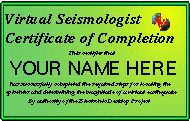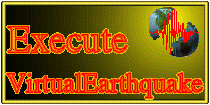
|

|
![]()
Welcome to Virtual EarthquakeVirtual Earthquake is an interactive Web-based activity designed to introduce you to the concepts of how an earthquake EPICENTER is located and how the RICHTER MAGNITUDE of an earthquake is determined. The Virtual Earthquake program is running on a Web Server at California State University at Los Angeles. You can interact with Virtual Earthquake using either a Netscape or Internet Explorer Web Browser running on Macs or PCs. NEW: A completely revised version of Virtual Earthquake can be found HERE. This new Java applet based version is more inquiry-based than the original version and contains tools so instructors can assess student learning.
(After you complete Virtual Earthquake, check out the Geology
Labs home page for activities
about mineral and radiocarbon age dating, river discharge, and river flooding.)
Virtual Earthquake will show you the recordings of an earthquake's seismic waves detected by instruments far away from the earthquake. The instrument recording the seismic waves is called a seismograph and the recording is a seismogram. The point of origin of an earthquake is called its focus and the point on the earth's surface directly above the focus is the epicenter. You are to locate the epicenter of an earthquake by making simple measurement on three seismograms that will be sent to you by the Virtual Earthquake program. Additionally, you will be required to determine the Richter Magnitude of that quake from the same recordings. Richter Magnitude is an estimate of the amount of energy released during and earthquake. Upon completion of this activity you will be given the opportunity to receive a personalized Certificate as a "Virtual Seismologist."  In order to get this certificate, you must make careful measurements throughout the activity. The actual certificate is much larger than the one displayed above. Click on the Execute button below to start the Virtual Earthquake application.
Contact Us |
